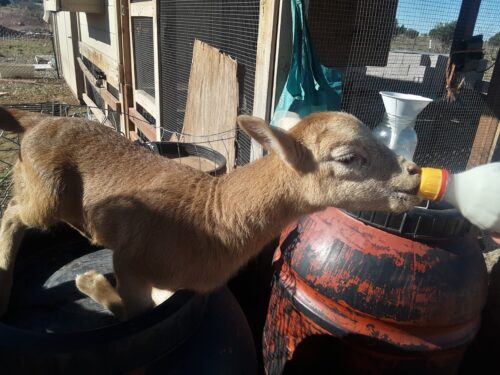
Hi, Phoenix here. Today I want to talk about the importance of partnership in homesteading. There are times when I have to travel for work (like my fieldwork) or one of us gets sick or injured (like my hurt wrist). It’s during those times that having a partner makes the difference between sustainable and not sustainable. Partnership is crucial for maintaining the sustainability I strive for at the homestead: physical, mental/emotional, financial, and environmental.
Physical:
Let’s face it–homesteading is hard. K and I do most of the physical tasks together. Neither of us would be able to do this by ourselves. Every week we haul several 50-pound feed bags and buckets of water, wrangle goats and sheep, corral chickens, and garden. Regularly, we repair vehicles and fix up houses and their solar systems, but the repairs needed are unpredictable. Seasonally, we help birth and raise goats and sheep, castrate male goat kids and lambs, do dairy farming, slaughter animals and put up the meat, and more. These tasks really need two people–for example, one person holds the lamb while another places the castration band.
The most difficult task for me is putting up and fixing fences. To put up a new perimeter fence involves driving a 100 t-posts, running several strands of barbed wire and tension wire, and putting up chain link fabric which comes in 75-pound rolls. These tasks also require two people. One person holds the stretched chain link fabric while another secures it to the post. It took three people (me, my dad, and K) two weeks of working continuously together to fence in one property to keep the animals in, and more importantly, the two-legged and 4-legged intruders out.
Mental/emotional:
We’re lucky to have so much life on a homestead with the births of goat kids, lambs, and chicks. But there are also a lot of deaths. Recently one of our ewes had difficulty birthing twins. The vet tried for a long time to help the ewe give natural birth, but when that didn’t work we decided to euthanize her and do a C-section to get the lambs out in the hope they were still alive after such a lengthy labor. The lambs were alive, but one had too much mucus in his lungs and even with all the vet’s efforts to clear his lungs he didn’t make it. Fortunately, his sister did. K and I have been bottle-feeding her and she looks healthy now. During these times of loss, having a partner to process the grief helps keep in mind the life surrounding us.
Similarly, K helps me keep my depression and anxiety at bay, especially when I’m mentally exhausted from my full time job, a PTSD episode, or full-on burnout like I’m experiencing now. I also try to help K when he’s dealing with triggers and work stress. Being alone would be mentally and emotionally unhealthy for either of us.
Financial:
One of the reasons I started homesteading was to have a sense of security during times of financial instability off the homestead. As a country, we now find ourselves in another state of uncertainty with a looming lapse in appropriations for the federal government. The 35-day shutdown in 2018-19 was very scary without income. For me, a month without pay checks was a real hardship with rent, utilities, grocery and other bills due. On the off-grid homestead, we don’t have to worry about rent and utilities, and our grocery bills are lower. Life outside a city doesn’t mean no expenses. There are still some, like buying feed and water. Partners with two sources of income help create a financial buffer and maintain financial sustainability.
Partnering with K has been essential to maintaining a sustainable lifestyle on our homestead while I’ve been away on work travel and navigating burnout. He fed and provided water for the animals, milked the goats, watered the plants and fruit trees, and kept the homestead running. I can’t emphasize enough the importance of having a partner when going into such an endeavor as homesteading. It makes the difference between failure and success. And as K says, two can survive, but to thrive you need a community. We’re working with our neighbors to establish a community for mutual sustainability now.
Next blog post: Part 2: Burnout–Recovery
